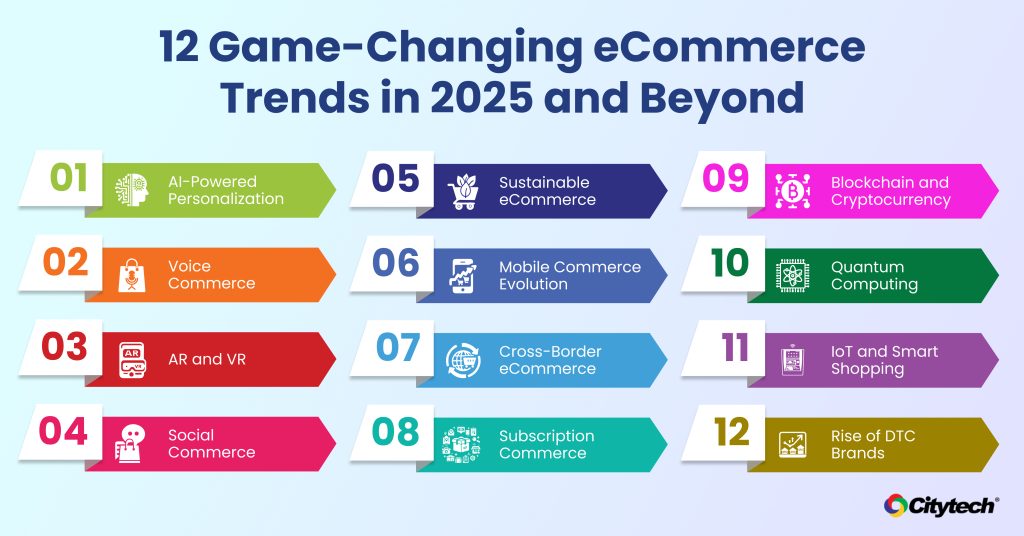The rapid evolution of technology has completely transformed the way we shop. As we stand on the precipice of 2025, the eCommerce landscape is poised for a seismic shift. No longer a mere convenience, online shopping is becoming an integral part of our daily lives.
In this digital age, consumers demand seamless, personalized, and innovative experiences. Businesses, in turn, are racing to adapt to these evolving expectations. From artificial intelligence to augmented reality, a myriad of technological advancements is set to revolutionize the way we buy and sell online.
As consumers, we’ve witnessed the rapid rise of online shopping. But the transformation isn’t limited to B2C. B2B eCommerce is experiencing explosive growth, driven by the increasing preference for digital channels. With a staggering $20.9 trillion projected for the global B2B eCommerce market by 2027, it’s clear that online marketplaces are the future. According to a Gartner report, 80% of all B2B sales interactions are expected to occur online by 2025.
In this blog post, we’ll delve into 12 groundbreaking trends that will shape the future of eCommerce. These eCommerce trends will not only redefine the customer journey but also empower businesses to thrive in the increasingly competitive digital marketplace.
What are the Future eCommerce Trends?

Trend 1: AI-Powered Personalization
Artificial intelligence is revolutionizing the way businesses interact with customers. By analyzing vast amounts of data, AI algorithms can predict preferences, tailor product recommendations, and create hyper-personalized shopping experiences.
Example
Amazon’s recommendation engine suggests products based on past purchases and browsing history.
Impact on eCommerce Business
This level of personalization not only enhances customer satisfaction but also drives sales and loyalty.
Trend 2: Voice Commerce
Voice assistants like Alexa and Google Assistant are becoming increasingly popular, and voice commerce is on the rise. Consumers can now make purchases using voice commands, making the shopping process more convenient and hands-free.
Example
Brands like Domino’s Pizza have embraced voice commerce, allowing customers to order their favorite pizza with a simple voice command.
Impact on eCommerce Business
This eCommerce trend is particularly appealing to busy consumers who prioritize convenience.
Trend 3: Augmented Reality (AR) and Virtual Reality (VR)
AR and VR technologies are transforming the online shopping experience. By overlaying digital information onto the real world, AR can help consumers visualize products in their own environment.

Example
IKEA’s AR app allows users to see how furniture would look in their homes before purchasing. VR, on the other hand, can create immersive shopping experiences, transporting consumers to virtual stores.
Impact on eCommerce Business
These technologies can significantly reduce return rates and boost customer satisfaction.
Trend 4: Social Commerce
Social media platforms are evolving into powerful shopping channels. Platforms like Instagram and TikTok have integrated shopping features, allowing users to discover and purchase products directly from their feeds. Influencer marketing and user-generated content are also driving social commerce.
Example
Amazon leverages its own platform, Amazon Live, to feature influencers and brands showcasing products in real-time. During these sessions, viewers can purchase products directly via integrated links.
Sephora uses Instagram Live and TikTok to host beauty tutorials and product demonstrations. Experts and influencers interact with viewers, answer questions, and offer product recommendations.
Impact on eCommerce Business
By leveraging social media, businesses can reach a wider audience and generate buzz around their products.
Trend 5: Sustainable eCommerce
Consumers are becoming increasingly conscious of environmental and social issues. Sustainable eCommerce practices, such as eco-friendly packaging, ethical sourcing, and carbon-neutral shipping, are gaining traction.
Example
Brands like Allbirds, known for their sustainable footwear, have successfully tapped into this trend.
Impact on eCommerce Business
By prioritizing sustainability, businesses can attract environmentally conscious consumers and build a positive brand reputation.
Trend 6: Mobile Commerce Evolution
Mobile commerce continues to dominate the eCommerce landscape. As smartphones become increasingly powerful, consumers are turning to their devices for shopping. Mobile-optimized websites and user-friendly mobile apps are essential for businesses to capture this growing market.
Example
Starbucks’ mobile app allows customers to order and pay for their coffee ahead of time, streamlining the entire process.
Impact on eCommerce Business
This eCommerce trend has led to a surge in online sales and increased customer convenience.
Trend 7: Cross-Border eCommerce
Cross-border eCommerce enables businesses to sell their products to customers in different countries.
Example
Apple utilizes cross-border eCommerce to sell its products globally through its regional online stores and authorized resellers. They integrate localization for currency, language, and compliance.
Impact on eCommerce Business
With the rise of global e-commerce platforms like Amazon and Alibaba, it’s easier than ever for businesses to expand their reach. However, cross-border eCommerce presents unique challenges, such as customs duties, shipping costs, and language barriers. By overcoming these challenges, businesses can tap into lucrative international markets.
Trend 8: Subscription Commerce
Subscription commerce models, where customers pay a recurring fee to receive products or services, have gained popularity. This trend is particularly prevalent in industries like beauty, food, and fashion.

Example
Dollar Shave Club offers a subscription service for razors and other grooming products.
Impact on eCommerce Business
Subscription models provide a steady revenue stream for businesses and foster customer loyalty.
Trend 9: Blockchain and Cryptocurrency in eCommerce
Blockchain technology offers transparency, security, and trust in online transactions. Cryptocurrencies like Bitcoin and Ethereum are gaining acceptance as payment methods.
Example
Microsoft allows customers to use Bitcoin to top up their Microsoft accounts. These funds can be used to purchase apps, games, and other digital content from their platforms.
Twitch, the popular streaming platform, accepts cryptocurrency payments for subscriptions, including Bitcoin, Ether, and Dogecoin.
Impact on eCommerce Business
While still in its early stages, blockchain and cryptocurrency have the potential to revolutionize eCommerce by streamlining supply chain management, reducing fraud, and enabling secure cross-border payments.
Trend 10: Quantum Computing and eCommerce
Quantum computing, with its immense processing power, can solve complex problems that are beyond the capabilities of classical computers.
Example
The Chinese eCommerce giant, JD.com, has invested in quantum computing to explore solutions for improving delivery routes and minimizing shipping times.
Impact on eCommerce Business
In the context of eCommerce, quantum computing can optimize supply chain logistics, improve fraud detection, and enhance personalized recommendations. While still in its nascent stage, quantum computing has the potential to significantly impact the future of eCommerce.
Trend 11: The Internet of Things (IoT) and Smart Shopping
IoT devices are becoming increasingly integrated into our daily lives. These devices can automate tasks like reordering household items, making shopping more convenient.
Example
Nike’s IoT-powered stores integrate their mobile app, allowing customers to scan products for details, request sizes, and even reserve items to try.
Impact on eCommerce Business
By leveraging IoT, businesses can gather valuable customer data and offer personalized product recommendations.
Trend 12: The Rise of Direct-to-Consumer (DTC) Brands
DTC brands are bypassing traditional retailers and selling directly to consumers online. This trend has empowered brands to build stronger relationships with their customers and offer unique products at competitive prices.
Example
Brands like Warby Parker, Glossier, Allbirds, and Casper exemplify the DTC model by creating strong brand identities. They offer personalized customer experiences and leverage digital platforms to build direct relationships with their audience.
Impact on eCommerce Business
By controlling the entire customer journey, DTC brands can deliver a consistent and personalized experience.
The Future of Retail: A Blend of Online and Offline
The future of retail lies in a seamless integration of online and offline channels. Omnichannel strategies, which provide a consistent customer experience across all touchpoints, are essential for success. Features like buy online, pick up in-store (BOPIS) and curbside pickup offer flexibility and convenience to consumers. By combining the best of both worlds, businesses can create a truly omnichannel shopping experience.
Conclusion
The 12 eCommerce trends we’ve explored in this blog post are set to reshape the industry in 2025, offering unparalleled convenience, personalization, and innovation. As these eCommerce trends continue to evolve, businesses that embrace innovation and adapt to changing consumer behaviors will emerge as leaders in the digital age.

